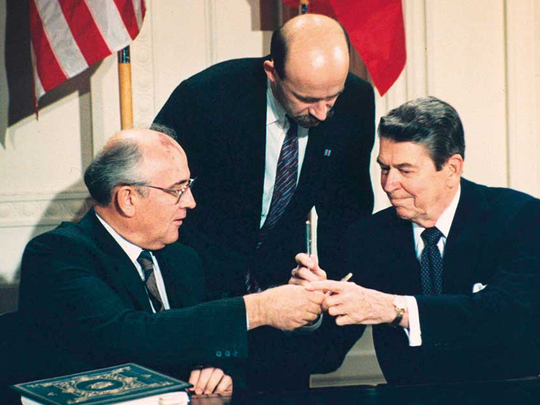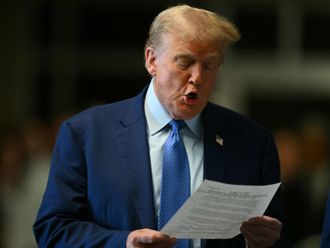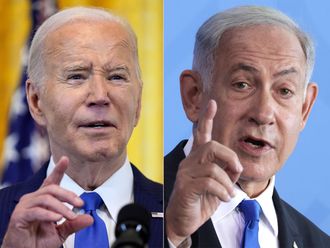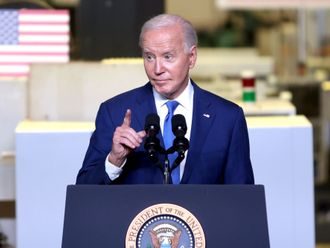
Washington: The Trump administration has confirmed that it will exit the landmark Cold War-era Intermediate-Range Nuclear Forces Treaty with Russia, in part to enable the US to counter a Chinese arms buildup in the Pacific. Moscow criticised the move as Washington’s latest effort to be the sole global superpower.
Trump claims Russia has long violated the three-decade-old Intermediate-Range Nuclear Forces Treaty, known as the INF, was signed in 1987 by president Ronald Reagan and Soviet leader Mikhail Gorbachev.
But a Russian foreign ministry source told the RIA Novosti state news agency that Washington’s “main motive is a dream of a unipolar world,” one that won’t be realised.
What has Trump said?
The year when the Intermediate-Range Nuclear Forces Treaty, known as the INF, was signed by US president Ronald Reagan and Soviet leader Mikhail Gorbachev.
The Trump administration has complained of Moscow’s deployment of 9M729 missiles, which Washington says can travel more than 500km and thus violate the INF treaty. “We’re the ones who have stayed in the agreement and we’ve honoured the agreement, but Russia has not unfortunately honoured the agreement, so we’re going to terminate the agreement and we’re going to pull out,” US President Donald Trump told reporters in Nevada.
“Russia has violated the agreement. They’ve been violating it for many years. I don’t know why president [Barack] Obama didn’t negotiate or pull out. And we’re not going to let them violate a nuclear agreement and go out and do weapons [while] we’re not allowed to.”
Why is the treaty a problem for the US?
The treaty, which banned missiles that could travel between 310 and 3,400 miles, resolved a crisis that had begun in the 1980s with the deployment of Soviet SS-20 nuclear-tipped, intermediate-range ballistic missiles targeting Western capitals.
But the pact has constrained the US from deploying new weapons to respond to China’s efforts to cement a dominant position in the Western Pacific and to keep US naval forces at bay. Because China was not a signatory to the treaty, it has faced no limits on developing intermediate-range nuclear missiles, which can travel thousands of miles.
How has Russia responded?
Moscow yesterday warned Trump that his plan to ditch the Cold War-era nuclear weapons treaty was a dangerous step. Russian deputy foreign minister Sergei Ryabkov said this “would be a very dangerous step” and accused the US of risking international condemnation in a bid for “total supremacy” in the military sphere.
He insisted that Moscow observed “in the strictest way” the three-decade-old Intermediate-Range Nuclear Forces Treaty, known as the INF, while accusing Washington of “flagrant violations.”
Will this trigger a new arms race?
Now that the INF treaty is in tatters, the question is whether the decision to leave it will accelerate the increasingly Cold War-like behaviour among the three superpowers: the United States, Russia and China. As Russia has flown bombers over Europe and has conducted troop exercises on its borders with former Soviet states, the US and its Nato allies have been rotating forces through countries under threat.
Ukraine has become a low-level battleground, with ground skirmishes and a daily cyberconflict. China and the US are jostling for position around reefs in the South China Sea that Beijing has turned into military bases, and they are both preparing for any possibility of war in space.
What is Trump’s China strategy?
The Pentagon has been developing nuclear weapons to match, and counter, what the Chinese have deployed. But that effort would take years, so, in the interim, the US is preparing to modify existing weapons, including its non-nuclear Tomahawk missiles, and is likely to deploy them first in Asia, according to officials who have been briefed on the issue. Those may be based in Japan, or perhaps in Guam, where the US maintains a large base and would face little political opposition.
What happens now?
Jon Wolfsthal, a nuclear expert on the National Security Council during the Obama administration, said a withdrawal would roil Europe. “Things are just now calming down,” he said. “This would be another hand grenade in the middle of Nato to split the allies.”
The 1987 treaty between Washington and Moscow bans all land-based missiles with ranges of 500 to 5,500 km, or 310 to 3,420 miles. Missiles that go that far are known as short- and intermediate-range. The treaty covers land-based missiles carrying both nuclear and conventional warheads. It does not cover air-launched or sea-launched weapons.
Last time US withdrew from key arms treaty?
The year President George W Bush pulled the US out of the Anti-Ballistic Missile Treaty.
It was in 2002, when President George W Bush pulled the US out of the Anti-Ballistic Missile Treaty, which banned weapons designed to counter ballistic nuclear missiles. His administration’s move to set up a missile shield in Europe alarmed the Kremlin, and was scrapped by the Obama administration in 2009. It was replaced by a modified defence system in 2016.
—New York Times News Service
UK defence minister backs Trump move to exit nuclear pact
Britain’s defence secretary says the UK stands “absolutely resolute” with the United States as President Donald Trump announced he will pull out from a landmark arms control agreement with Russia.
Gavin Williamson blamed Russia for endangering the arms control pact, agreed between the US and the Soviet Union in 1987, and called on the Kremlin to “get its house in order.” Trump said he will exit the pact because Russia has violated it “for many years” and it’s preventing the US from developing new weapons. Backing Trump, Williamson told the Financial Times yesterday that Moscow had made a “mockery” of the Intermediate-Range Nuclear Forces Treaty.
The 1987 pact prohibits the United States and Russia from possessing, producing or test-flying a ground-launched cruise missile with a range of 300 to 3,400 miles.
—AP
WHAT NEXT?
■ US National Security Adviser John Bolton is set to meet next week with Russia’s Foreign Minister Sergei Lavrov, ahead of what is expected to be a second summit between US President Donald Trump and Russian leader Vladimir Putin this year.
■ Bolton is also set to meet Security Council Secretary Nikolai Patrushev and Putin aide Yuri Ushakov. A Kremlin spokesman said a “possible meeting” was being prepared between Putin and Bolton for a full discussion on the treaty.
■ The Trump administration is likely to deploy a version of the Tomahawk cruise missile that is redesigned to be launched from land.
■ Ships and submarines now carry Tomahawks armed with conventional warheads; experts say that eventually a nuclear warhead could be designed to fit the Tomahawk.
— Compiled from agencies
What is the Intermediate-Range Nuclear Forces treaty?
■ Soviet leader Mikhail Gorbachev and US President Ronald Reagan signed the INF treaty in 1987
■ The arms control deal banned all nuclear and non-nuclear missiles with short and medium ranges, except sea-launched weapons
■ The US had been concerned by the Soviet deployment of the SS-20 missile system and responded by placing Pershing and Cruise missiles in Europe — sparking widespread protests
By 1991, nearly 2,700 missiles had been destroyed. Both countries were allowed to inspect the other insatallations
■ In 2007, Russian president Vladimir Putin declared the treaty no longer served Russia’s interests. The move came after the US withdrew from the Anti-Ballistic Missile Treaty in 2002












